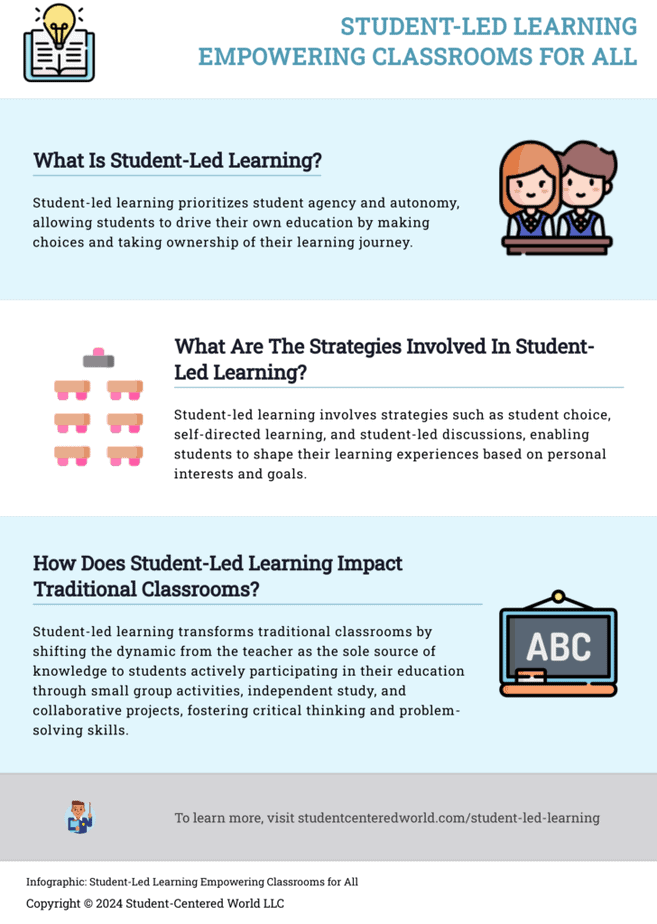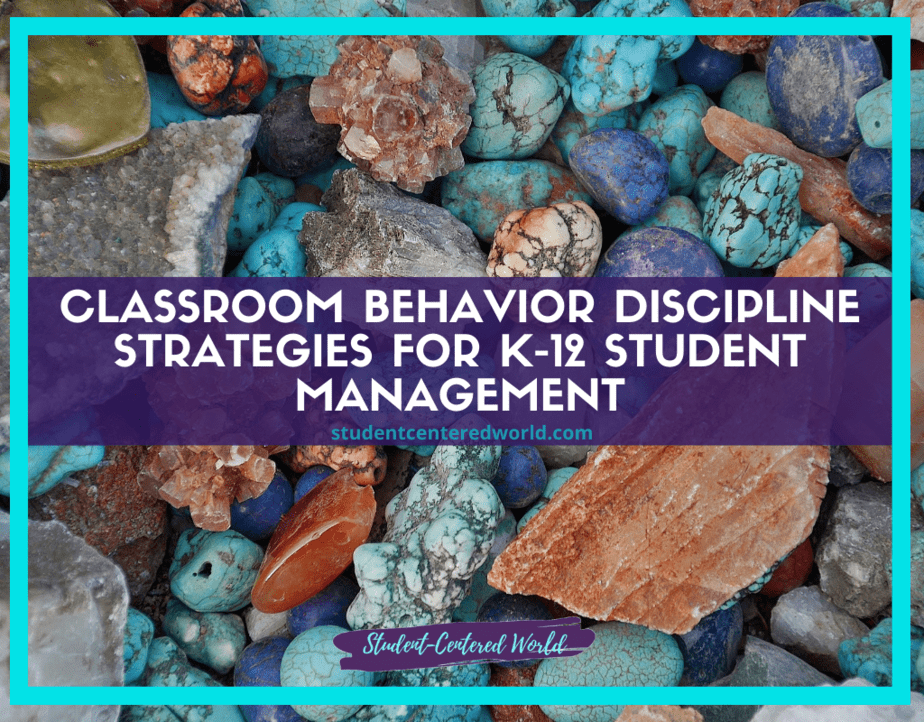Student-Led Learning: Empowering Classrooms for All
In the ever-evolving landscape of education, one approach has been gaining traction for its remarkable benefits to students and teachers alike: student-led learning. This educational philosophy puts students at the forefront of their own learning journey, allowing them to take ownership, make choices, and drive their education forward. Let’s explore what student-led learning entails, its myriad benefits, and how it can transform traditional classrooms into dynamic hubs of critical thinking and deep learning.
Understanding Student-Led Learning
At its core, student-led learning prioritizes student agency and autonomy. It encompasses various strategies such as student choice, self-directed learning, and student-led discussions. Rather than being passive recipients of information, students become active participants in their education, shaping their learning experiences based on personal interests, goals, and learning styles.
In a student-led classroom, the dynamic shifts from the teacher being the sole disseminator of knowledge to students taking on active roles in their own learning process. Instead of whole class instruction, students may engage in small group activities, independent study, or collaborative projects. This approach fosters critical thinking, problem-solving skills, and deep understanding as students grapple with complex concepts and real-world applications.
The Benefits of Student-Led Learning
- Promotes Critical Thinking: By encouraging students to ask questions, explore diverse perspectives, and solve problems independently, student-led learning cultivates critical thinking skills essential for success in the 21st century.
- Fosters Student Agency: When students have the freedom to choose their learning paths, set personal goals, and pursue their interests, they develop a sense of ownership and empowerment over their education.
- Encourages Collaboration: Through student-led discussions, group projects, and small group activities, students learn to collaborate effectively, communicate ideas, and support one another’s learning, mirroring real-world interactions.
- Tailored to Individual Needs: Student-led learning allows for personalized learning paths, accommodating the diverse needs, abilities, and interests of each student, regardless of grade level or age group.
- Prepares Lifelong Learners: By instilling a growth mindset and a love for learning, student-led education nurtures lifelong learners who are curious, adaptable, and equipped to thrive in an ever-changing world.
The shift towards student-led learning represents a fundamental change in the mindset of educators and education leaders worldwide. By embracing this approach, schools can create vibrant learning environments where students are actively engaged, empowered, and invested in their education.
Ultimately, student-led learning goes beyond the classroom walls, preparing students to navigate the complexities of the outside world with confidence and competence. As education continues to evolve, student-led learning stands as a beacon of innovation and excellence, offering students the opportunity to chart their own course and shape their own future. It’s not just a trend; it’s the future of education.
A learner-centric environment holds the key to unlocking the full potential of every student, fostering a generation of independent thinkers, problem solvers, and lifelong learners. As educators, it is our duty to embrace this transformative approach, empowering students to take ownership of their learning and embark on their own educational adventures. The journey may be challenging, but the rewards are immeasurable. Let’s embark on this journey together and pave the way for a brighter future for our students and society as a whole.
Implementing Effective Student-Led Learning
To create a successful student-led learning environment, educators can take several steps:
- Empower Student Voice: Encourage students to express their interests, questions, and concerns, and incorporate their input into lesson plans and activities.
- Establish Clear Expectations: Set clear guidelines and expectations for student-led activities, ensuring that students understand their roles and responsibilities.
- Provide Support and Guidance: While students take the lead, teachers serve as facilitators, providing guidance, feedback, and support as needed.
- Use Formative Assessments: Assess student progress through formative assessments that focus on understanding, growth, and mastery rather than grades.
- Utilize Technology: Leverage communication technologies and digital tools to facilitate collaboration, research, and exploration of diverse resources.
Implementing a student-centered classroom not only transforms the educational experience for students but also significantly reduces stress and enhances enjoyment for teachers. By decentralizing traditional teacher-led learning, educators find themselves liberated from the pressure of constantly leading and directing every aspect of the classroom via constant direct instruction. Instead, they become facilitators, guiding and supporting students choices and students’ needs as they take charge of their own learning journey.
This shift in the mindset of the staff not only fosters a more collaborative and harmonious classroom environment but also allows teachers to witness their students’ growth and development firsthand, which can be incredibly rewarding. With students actively engaged in their learning and taking ownership of their education, personal strengths, and their own concerns in terms of inquiry, teachers can focus on fostering meaningful connections, inspiring curiosity, and nurturing a genuine love for learning, ultimately making teaching a more fulfilling and enjoyable experience.
The Impact of Student-Led Learning
The shift towards student-led learning represents a fundamental change in the mindset of educators and education leaders worldwide. By embracing this approach, schools can create vibrant learning environments where students are actively engaged, empowered, and invested in their education.
In a learner-centered classroom, where student interests and needs are prioritized, the impact on student engagement and intrinsic motivation is profound. Through activities such as student-led conferences, small group discussions, and project-based learning, students are actively involved in their own learning process, which serves as a great way to enhance their motivation. Socratic seminars and group work provide platforms for students to explore different perspectives and collaborate with their peers, fostering a positive impact on their learning experiences.
The allotted time is utilized efficiently as students delve into historical events and real-world problems, guided by their own interests and concerns. By allowing students to choose their own adventures and ask the right questions, they become more invested in their learning, leading to a better understanding of the material and the development of their own strengths as independent learners. This approach is applicable across grade levels and age groups, from middle school to high school, as it empowers students to take ownership of their learning journeys and prepares them for success in a digital, real-world environment.

The learner-centered classroom environment not only cultivates a growth mindset among students but also promotes mutual support and collaboration among peers, making it the best thing for fostering student engagement and intrinsic motivation.
Ultimately, student-led learning goes beyond the classroom walls, preparing students to navigate the complexities of the outside world with confidence and competence. As education continues to evolve, student-led learning stands as a beacon of innovation and excellence, offering students the opportunity to chart their own course and shape their own future. It’s not just a trend; it’s the future of education.
In conclusion, student-led learning holds the key to unlocking the full potential of every student, fostering a generation of independent thinkers, problem solvers, and lifelong learners. As educators, we must embrace this transformative approach, empowering students to take ownership of their learning and embark on their own educational adventures. The journey may be challenging, but the rewards are immeasurable. Let’s embark on this journey together and pave the way for a brighter future for our students and society as a whole.
Want to learn more?
Are you ready to revolutionize your classroom and empower your students to take charge of their own learning journey? Join me for “The Teacher’s Guide to Student-Led Learning” workshop, where you’ll gain practical strategies and valuable insights on successfully implementing student-led learning in your classroom.
Learn how to foster student engagement, intrinsic motivation, and critical thinking skills while creating a dynamic and student-centered learning environment.
For a limited time, this 40-minute online workshop, normally priced at $29, is available for only $6! Plus, you have access to it for any time you’d like to refresh AND you’ll receive a 40-minute completion certificate when you finish. We all need PD hours…why not snag them for a topic that has meaning?
Don’t miss out on this incredible opportunity to transform your teaching practices and inspire lifelong learners.






